by Bruce Wells | Mar 2, 2025 | Petroleum Pioneers
As drillers and speculators rushed to Spindletop Hill, the Texas Company was organized in 1902.
A series of oil and natural gas discoveries at Sour Lake, Texas — near the famous 1901 gusher at Beaumont — helped launch the major oil company Texaco.
Originally known as Sour Lake Springs because of sulfurous spring water popular for its healing properties, a series of oil discoveries brought wealth and new petroleum companies to Hardin County in southeastern Texas.
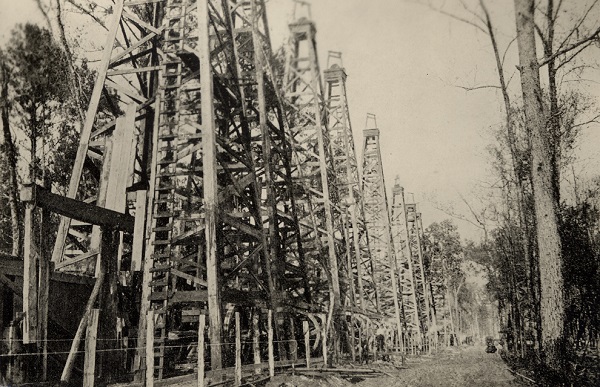
“A forest of oil well derricks at Sour Lake, Texas,” is from the W.D. Hornaday Collection, Texas State Library and Archives Commission, Austin. Oil discoveries at the resort town northwest of the world-famous Spindletop gusher of 1901 would transform the Texas Company.
As the science of petroleum exploration and production evolved, some geologists predicted oil was trapped at a salt dome at Sour Lake similar to that of Beaumont’s Spindletop Hill formation, which was producing massive amounts of oil.
According to Charles Warner in Texas Oil & Gas Since 1543, in November 1901 an exploratory well found “hot salt water impregnated with sulfur between 800 and 850 feet…and four oil sands about 10 feet thick at a depth of approximately 1,040 feet.”

Warner noted that the Sour Lake Springs field’s discovery well came four months later when a second attempt by the Great Western Company drilled “north of the old hotel building” in the vicinity of earlier shallow wells.
“This well secured gusher production at a depth of approximately 683 feet on March 7, 1902,” Warner reported. “The well penetrated 40 feet of oil sand. The flow of oil was accompanied by a considerable amount of loose sand, and it was necessary to close the well in from time to time and bail out the sand, after which the well would respond with excellent flows.”
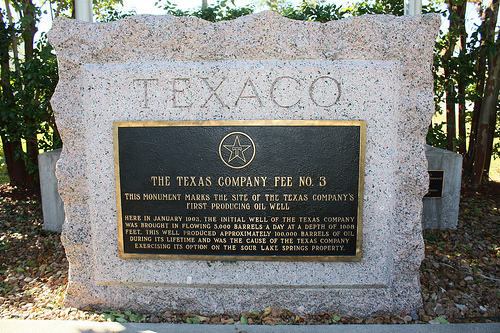
A monument marks the site where in 1903 the Fee No. 3 well flowed at 5,000 barrels of oil a day, launching the Texas Company into becoming Texaco.
As more discoveries followed, Joseph “Buckskin Joe” Cullinan and Arnold Schlaet were among those who rushed to the area from their offices in Beaumont.
The Texas Company
The most significant company that started during the Spindletop oil boom was The Texas Company, according to historian Elton Gish.

“Cullinan worked in the Pennsylvania oil industry and later went to Corsicana, Texas, about 1898 when oil was first discovered in that district where he became the most prosperous operator in the field,” reported Gish in his “History of the Texas Company and Port Arthur Works Refinery.”
Cullinan formed the Petroleum Iron Works, building oil storage tanks in the Beaumont area — where he was introduced to Schlaet. “When the Spindletop boom came in January 1901, Mr. Cullinan decided to visit Beaumont,” Gish noted. Schlaet managed the oil business of two brothers, New York leather merchants.
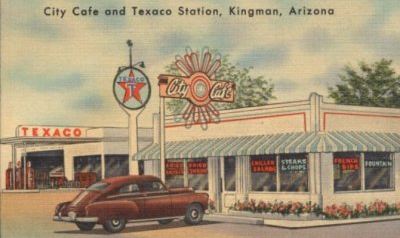
Named after its New York City telegraph address, the Texaco brand became official in 1959. Postcard of a Texaco service station next to a cafe in Kingman, Arizona.
“Schlaet’s field superintendent, Charles Miller, traveled to Beaumont in 1901 to witness the Spindletop activity and met with Cullinan, whom he knew from the oil business in Pennsylvania. He liked Cullinan’s plans and asked Schlaet to join them in Beaumont.”
According to Texaco, Cullinan and Schlaet formed the Texas Company on April 7, 1902, by absorbing the Texas Fuel Company and inheriting its office in Beaumont. Texas Fuel had organized just one year earlier to purchase Spindletop oil, develop storage and transportation networks, and sell the oil to northern refineries.

By November 1902, the new Texas Company was establishing a new refinery in Port Arthur as well as 20 storage tanks, building its first marine vessel, and equipping an oil terminal to serve sugar plantations along the Mississippi River.
Fee No. 3 Discovery
The Texas Company struck oil at Sour Lake Springs in January 1903, “after gambling its future on the site’s drilling rights,” the company explained. “The discovery, during a heavy downpour near Sour Lake’s mineral springs, turned the company into a major oil producer overnight, validating the risk-taking insight of company co-founder J.S. Cullinan and the ability of driller Walter Sharp.”
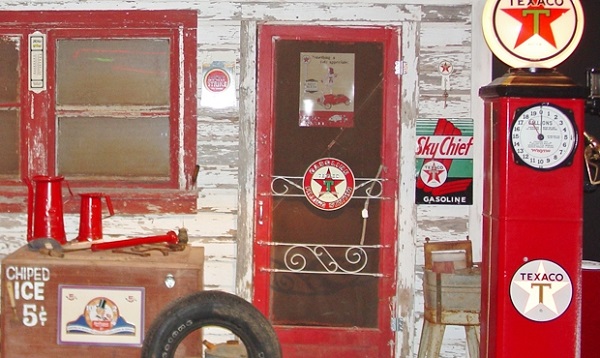
A Texaco station was among the 2012 indoor exhibits featured at the National Route 66 Museum in Elk City, Oklahoma. Photo by Bruce Wells.
Their 1903 Hardin County discovery at Sour Lake Springs — the Fee No. 3 well — flowed at 5,000 barrels a day, securing the Texas Company’s success in petroleum exploration, production, transportation and refining. Sharp founded the Sharp-Hughes Tool Company in 1908 with Howard Hughes Sr.
High oil production levels from the Sour Lake field and other successful wells in the Humble oilfield (1905), secured the company’s financial base, according to L. W. Kemp and Cherie Voris in Handbook of Texas Online.
“In 1905 the Texas Company linked these two fields by pipelines to Port Arthur, ninety miles away, and built its first refinery there. That same year the company acquired an asphalt refinery at nearby Port Neches,” the authors noted.

“In 1908 the company completed the ambitious venture of a pipeline from the Glenn Pool, in the Indian Territory (now Oklahoma), to its Southeast Texas refineries,” added Kemp and Voris. “As early as 1905 the Texas Company had established marketing facilities not only throughout the United States, but also in Belgium, Luxembourg, and Panama.”
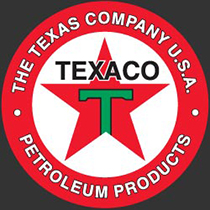
The Texas Company registered “Texaco” as a trademark in 1909.
The telegraph address for the company’s New York office is “Texaco” — a name soon applied to its products. The company registered its first trademark, the original red star with a green capital letter “T” superimposed on it in 1909. The letter remained an essential component of the logo for decades.
The Texas Corporation in August 1926 incorporated in Delaware (from Texas) and by an exchange of shares acquired outstanding stock of The Texas Company (Texas), which was dissolved the next year.
The new corporation became the parent company of numerous “Texas Company” — Texaco — entities and other subsidiaries, according to Jim Hinds of Columbus, Indiana (see Histories of Indian Refining, Havoline, and Texaco). By 1928, Texaco operated more than 4,000 gasoline stations in 48 states. It already was a major oil company when it officially renamed itself Texaco in 1959.
1987 Bankruptcy
Texaco lost a 1985 court battle following its purchase of Getty Oil Company. In February 1987 a Texas court upheld the decision against Texaco for having initiated an illegal takeover of Getty Oil after Pennzoil had made a bid for the company. Texaco filed for bankruptcy in April 1987.
The companies settled their historic $10.3 billion legal battle for $3 billion when Pennzoil agreed to drop its demand for interest. The Los Angeles Times reported the compromise was vital for Texaco emerging from bankruptcy, a haven sought to stop Pennzoil from enforcing the largest court judgment ever awarded at the time.

On October 9, 2001, Chevron and Texaco agreed to a merger that created ChevronTexaco — renamed Chevron in 2005. Although the Sour Lake Springs oil boom was surpassed by other Texas discoveries, it has remained the birthplace of Texaco.
Learn more about southeastern Texas petroleum history in Spindletop creates Modern Petroleum Industry and Prophet of Spindletop.
_______________________
Recommended Reading: The Texaco Story, The First Fifty Years 1902 – 1952 by Texas Company (1952). Texaco’s Port Arthur Works, A Legacy of Spindletop and Sour Lake (2003); Giant Under the Hill: A History of the Spindletop Oil Discovery (2008). Your Amazon purchase benefits the American Oil & Gas Historical Society. As an Amazon Associate, AOGHS earns a commission from qualifying purchases.
(2008). Your Amazon purchase benefits the American Oil & Gas Historical Society. As an Amazon Associate, AOGHS earns a commission from qualifying purchases.
_______________________
The American Oil & Gas Historical Society (AOGHS) preserves U.S. petroleum history. Please become an AOGHS annual supporter and help maintain this energy education website and expand historical research. For more information, contact bawells@aoghs.org. Copyright © 2025 Bruce A. Wells. All rights reserved.
Citation Information – Article Title: “Sour Lake produces Texaco.” Authors: B.A. Wells and K.L. Wells. Website Name: American Oil & Gas Historical Society. URL: https://aoghs.org/petroleum-pioneers/sour-lake-produces-texaco. Last Updated: March 1, 2025. Original Published Date: April 5, 2014.
by Bruce Wells | Feb 5, 2025 | Petroleum History Almanac
The Ranger who tamed oil and gas boom towns during the Great Depression. “Crime may expect no quarter.”
During much of the 1920s, a Texas Ranger became known for strictly enforcing the law in oilfield communities. By 1930, the discovery year of the largest oilfield in the lower 48 states, he was known as “El Lobo Solo” — the lone wolf — the Ranger who brought law and order to East Texas boom towns.
Manuel Trazazas Gonzaullas was born in 1891 in Cádiz, Spain, to a Spanish father and Canadian mother who were naturalized U.S. citizens. At age 15 he witnessed the murder of his only two brothers and the wounding of his parents when bandits raided their home. Fourteen years later, Gonzaullas joined the Texas Rangers.
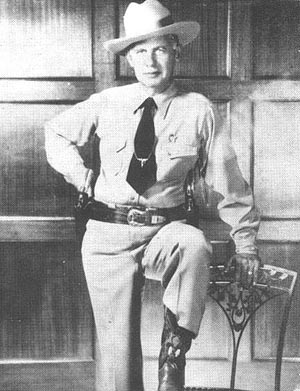
“Give Texas more Rangers of the caliber of ‘Lone Wolf’ Gonzaullas and the crime wave we are going through will not be of long duration,” reported the Dallas Morning News in 1934.
“He was a soft-spoken man and his trigger finger was slightly bent,” independent producer Watson W. Wise characterized him during a 1985 interview in Tyler, Texas. “He always told me it was geared to that .45 of his.” (more…)
by Bruce Wells | Jan 27, 2025 | This Week in Petroleum History
January 28, 1921 – “Vaseline Well” erupts in Oklahoma –
After reaching a depth of 3,710 feet, drillers of the W.C. Newman well near Lamar, Oklahoma, “hit into a strata of oil, the like of which never before, nor since has been found,” reported the Daily Oklahoman in a 1933 retrospective of the well, which “caused oil men to marvel then, as today, since it produces the same Vaseline-like content.” (more…)
by Bruce Wells | Jan 20, 2025 | This Week in Petroleum History
January 20, 1886 – Great Karg Well erupts Natural Gas in Ohio –
A well drilled for oil near Findlay, Ohio, erupted natural gas flowing at 12 million cubic feet per day from pressure that could not be controlled by technologies of the day. The “Great Karg Well” ignited into a flame that burned for four months and became a Findlay tourist attraction. Eight years earlier, a gas well in Pennsylvania had made similar headlines (see Natural Gas is King in Pittsburgh).
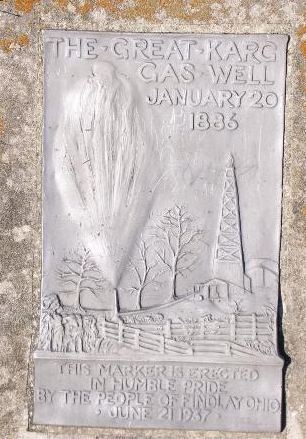
A plaque dedicated in 1937 at Findlay, Ohio, commemorated the state’s 1886 giant natural gas discovery.
Although Ohio’s first natural gas well was drilled in 1884 by the Findlay Natural Gas Company, the Karg well launched a gas-drilling boom that attracted manufacturing industries. Glass works companies were lured by the inexpensive gas (also see Indiana Natural Gas Boom), and new businesses included eight window glass factories, two bottle, two chimney lamp, one light bulb, one novelty, and five for tableware.
By 1887, Findlay was known as the “City of Light,” according to a historical marker erected in 1987 at the first field office of the Ohio Oil Company, which adopted the name Marathon Oil in 1962. The Hancock Historical Museum has preserved Great Karg Well history less than two miles from the well site.
January 21, 1865 – Testing the Roberts Torpedo
Civil War veteran Col. Edward A.L. Roberts (1829-1881) conducted his first experiment to increase oil production by using an explosive charge deep in the well. Roberts twice detonated eight pounds of black powder 465 feet deep in the bore of the “Ladies Well” on Watson’s Flats south of Titusville, Pennsylvania.
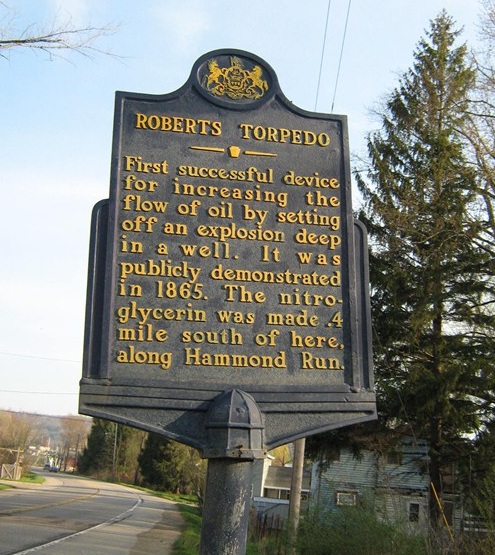
Civil War veteran Col. E.A.L. Roberts demonstrated his oil well “torpedo” south of Titusville, Pennsylvania.
The “shooting” of the well was a success, increasing daily production from a few barrels of oil to more than 40 barrels, according to Pennsylvania Heritage Magazine. By 1870, Roberts’ torpedoes using nitroglycerin became common in oilfields.
In April 1865, Roberts received the first of many patents for his “exploding torpedo,” and one year later the Titusville Morning Herald reported, “Our attention has been called to a series of experiments that have been made in the wells of various localities by Col. Roberts, with his newly patented torpedo. The results have in many cases been astonishing.”

January 22, 1861 – Pennsylvania Stills produce Kerosene
The first U.S. multiple-still oil refinery was brought on-stream one mile south of Titusville, Pennsylvania, by William Barnsdall, who had drilled the second successful well after Edwin Drake’s first U.S. oil discovery. Barnsdall and partners James Parker and W.H. Abbott spent about $15,000 to build six stills for refining kerosene. Equipment was purchased in Pittsburgh and shipped up the Allegheny River to Oil City where a refinery produced two grades of kerosene, white and the less expensive yellow.
January 22, 1910 – Standard Oil of California strikes Oil
Standard Oil Company of California (Socal) drilled its first successful oil well, a gusher in Kern County that initially produced 1,500 barrels of oil a day from the Midway-Sunset field. The discovery came after the 1906 merger of Pacific Coast Oil Company (see First California Oil Well) and Standard Oil Company of Iowa to create Socal.
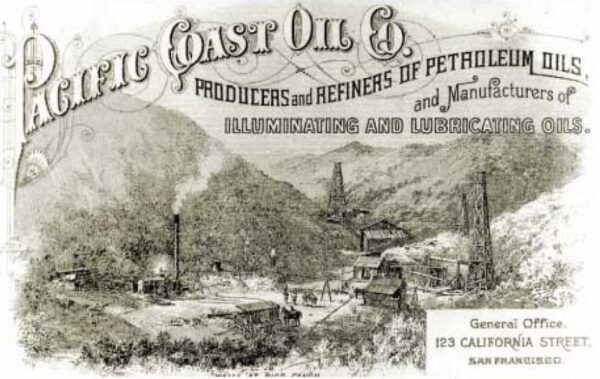
Standard Oil Company of California (Socal) began in 1879 as the Pacific Coast Oil Company and was renamed Chevron in 1981. Image courtesy Chevron.
The new company needed more oil reserves after it had “stepped up its marketing efforts, particularly in gasoline sales, which nearly doubled between 1906 and 1910,” according to a company history. “Until now, Standard had left the hunt for oil to others.”
The U.S. Supreme Court in 1911 ordered Socal separated from its parent, Standard Oil Company of New Jersey. After absorbing Standard Oil of Kansas in 1961 and making other acquisitions, the California company in 1984 rebranded as Chevron, headquartered in San Ramon.

January 23, 1895 – Standard Oil closes Oil Exchanges
Standard Oil Company of New Jersey’s purchasing agency in Oil City, Pennsylvania, notified independent oil producers it would only buy their oil at a price “as high as the markets of the world will justify” — and not “the price bid on the oil exchange for certificate oil.”
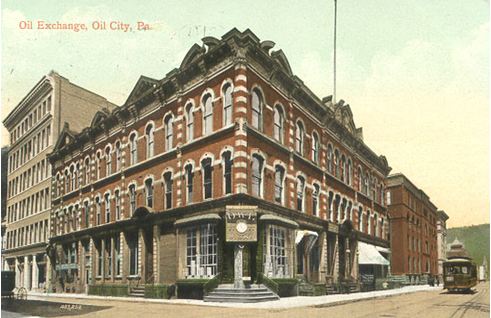
The Oil City, Pennsylvania, Oil Exchange was incorporated in 1874. Three years later, it was the third-largest U.S. financial exchange.
Oil City’s exchange had become the third largest financial exchange of any kind in America, behind New York and San Francisco. But with the Standard Oil Company buying 90 percent of oil production and setting its own price for certificates, all other oil exchanges soon closed.
Learn more in End of Oil Exchanges.
January 23, 1957 – Wham-O launches a New Petroleum Product
Among the earliest mass-produced products made from plastic, the “Frisbee” was introduced by Wham-O Manufacturing Company of California. The polymer toy originated in 1948 when a company called Partners in Plastic sold its “Flyin’ Saucers” for 25 cents each. In 1955, Richard Knerr and Arthur “Spud” Melin’s Wham-O bought the rights.
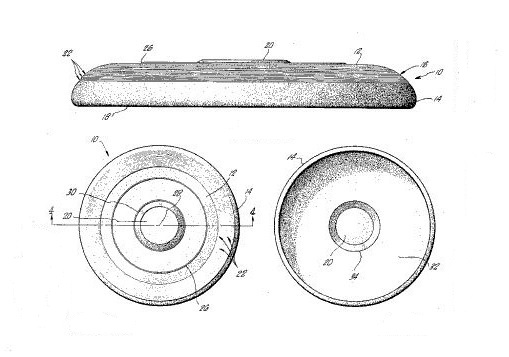
U.S. patent with mold details of a 1967 polyethylene plastic Frisbee.
The Wham-O founders discovered that Phillips Petroleum had invented a high-density polyethylene (called Marlex). They used the new plastic to meet phenomenal demand for manufacturing Frisbees – and Hula Hoops beginning in 1958.
Learn more in Petroleum Product Hoopla.
January 23, 1991 – Gulf War brings World’s Largest Oil Spill
The world’s largest oil spill began in the Persian Gulf when Saddam Hussein’s retreating Iraqi forces opened pipeline valves at oil terminals in Kuwait. About 11 million barrels of oil would cover an area extending 101 miles by 42 miles and reaching five inches thick in some places.
Iraqi soldiers sabotaged Kuwait’s main supertanker loading pier, dumping millions of gallons of oil into the Persian Gulf. By February, about 600 Kuwaiti wells had been set ablaze. It would take months to put out the well fires, with the last extinguished in early April (also see Oilfield Firefighting Technologies).

January 24, 1895 – Independent Producers found Pure Oil
To counter Standard Oil Company’s market dominance, Pennsylvania oil producers, refiners, and pipeline operators organized what would become a major Chicago-based oil venture. Originally based in Pittsburgh, Pure Oil Company quickly grew into the second vertically integrated U.S. petroleum company after Standard Oil.
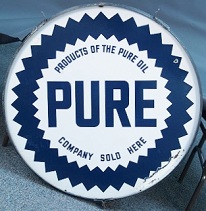
Ohio Cities Gas acquired Pure Oil in 1920 and kept the popular Pennsylvania brand name.
Beginning in early 1896, Pure Oil marketed its petroleum products by horse-drawn tank wagons in Philadelphia and New York — successfully competing with Standard Oil’s monopoly. The Ohio Cities Gas Company of Columbus acquired Pure Oil and in 1920 adopted the former Pennsylvania venture’s brand name.
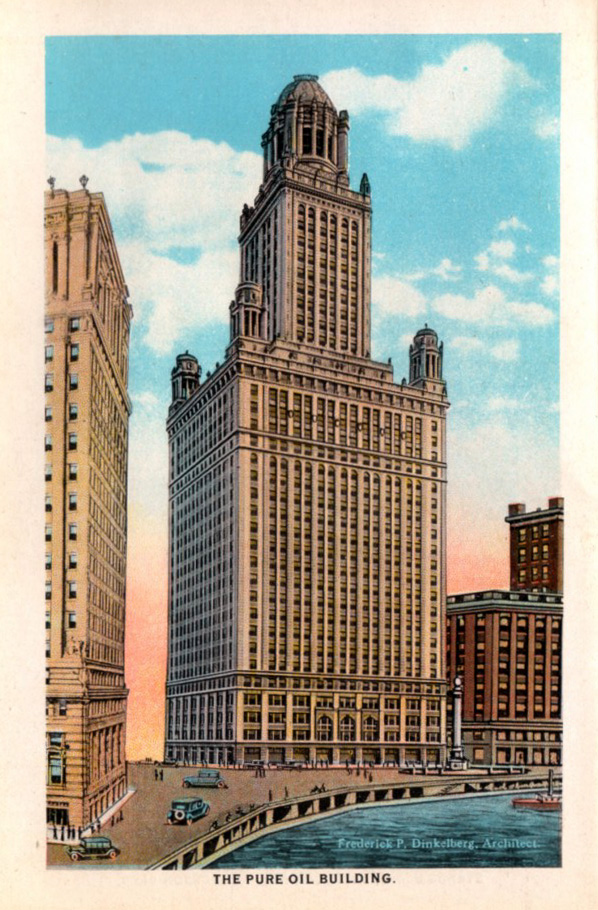
Pure Oil Company moved into its newly built 40-story Chicago headquarters on East Wacker Drive in 1926.
With a new Chicago headquarters opened in 1926, Pure Oil began exploring offshore technologies within a decade. The company developed early freestanding drilling platforms in the Gulf of Mexico.
January 25, 1930 – North Texas Oil Producers form Association
After meeting in Wichita Falls to protest “the recent drastic price cut in crude oil, inaugurated by some of the major purchasing companies,” 50 independent producers organized the North Texas Oil and Gas Association. Other issues included seeking a tariff on foreign oil imports and stopping “hot oil” oilfield thefts. The association merged with the West Central Texas Oil & Gas Association in 1998 to become the Texas Alliance of Energy Producers.

January 26, 1931 – Third Well reveals Extent of East Texas Oilfield
As East Texas farmers struggled to survive the Great Depression, an oil discovery confirmed the existence of a massive oilfield. W.A. “Monty” Moncrief of Fort Worth completed the Lathrop No. 1 well, which produced 7,680 barrels of oil a day from 3,587 feet deep. Geologists at first thought a third oilfield had been found.
Moncrief’s discovery well was 25 miles north of the famous Daisy Bradford No. 3 well of October 1930, drilled by Columbus Marion “Dad” Joiner. It was 15 miles north of the Lou Della Crim No. 1 well, completed at Kilgore three days after Christmas 1930. The 130,000-acre East Texas oilfield would become the largest in the lower 48 states.
Learn more in Moncrief makes East Texas History.
_______________________
Recommended Reading: Myth, Legend, Reality: Edwin Laurentine Drake and the Early Oil Industry (2009); Portrait in Oil: How Ohio Oil Company Grew to Become Marathon
(2009); Portrait in Oil: How Ohio Oil Company Grew to Become Marathon (1962); Ohio Oil and Gas, Images of America
(1962); Ohio Oil and Gas, Images of America (2008); Trek of the Oil Finders: A History of Exploration for Petroleum (1975). Titan: The Life of John D. Rockefeller, Sr.
(2008); Trek of the Oil Finders: A History of Exploration for Petroleum (1975). Titan: The Life of John D. Rockefeller, Sr. (2004); Plastic: The Making of a Synthetic Century
(2004); Plastic: The Making of a Synthetic Century (1996); Against the Fires of Hell: The Environmental Disaster of the Gulf War
(1996); Against the Fires of Hell: The Environmental Disaster of the Gulf War (1992); The Black Giant: A History of the East Texas Oil Field and Oil Industry Skulduggery & Trivia
(1992); The Black Giant: A History of the East Texas Oil Field and Oil Industry Skulduggery & Trivia (2003). Your Amazon purchase benefits the American Oil & Gas Historical Society. As an Amazon Associate, AOGHS earns a commission from qualifying purchases.
(2003). Your Amazon purchase benefits the American Oil & Gas Historical Society. As an Amazon Associate, AOGHS earns a commission from qualifying purchases.
_______________________
The American Oil & Gas Historical Society (AOGHS) preserves U.S. petroleum history. Become an AOGHS annual supporting member and help maintain this energy education website and expand historical research. For more information, contact bawells@aoghs.org. Copyright © 2025 Bruce A. Wells. All rights reserved.
by Bruce Wells | Jan 8, 2025 | Petroleum History Almanac
The North Texas church once proclaimed as richest in America.
In the fall of 1917 near Ranger, Texas, the cotton-farming town of Merriman was inhabited by “ranchers, farmers, and businessmen struggling to survive an economic slump brought on by severe drought and boll weevil-ravaged cotton fields.”
Everything changed in Eastland County when a wildcat well drilled by Texas & Pacific Coal Company struck oil at Ranger, four miles from Merriman. The J.H. McCleskey No. 1 well produced 1,600 barrels of oil a day.
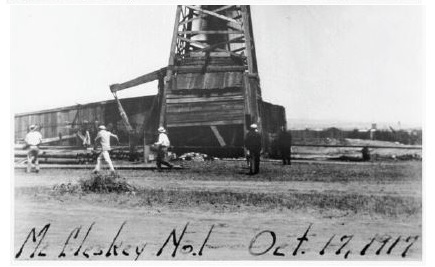
McCleskey No. 1 cable-tool oil well, the “Roaring Ranger” gusher of 1917, brought an oil boom to Eastland County, Texas, about 100 miles west of Dallas.
The rush to acquire leases that followed the oilfield discovery became legendary among drilling booms, even for Texas, home of the 1901 “Lucas Gusher” on Spindletop Hill at Beaumont.
As drilling continued, yield of the Ranger oilfield led to peak production reaching more than 14 million barrels in 1919. Production from the “Roaring Ranger” well and its giant North Texas oilfield helped win World War I — with a British War Cabinet member declaring, “the Allied cause floated to victory upon a wave of oil.”
Texas & Pacific Coal Company had taken a great risk by leasing acreage around Ranger, but the risk paid off when lease values soared. The exploration company added “oil” to its name, becoming the Texas Pacific Coal and Oil Company.
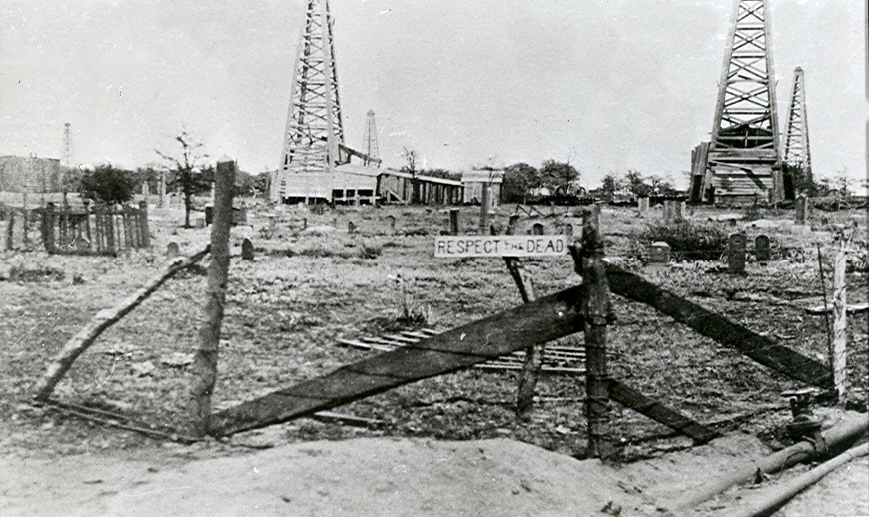
“So as we could not worship God on the former acre of ground, we decided to lease it and honor God with the product,” explained Merriman Baptist Church Deacon J.T. Falls. Photo courtesy Robert Vann, “Lone Star Bonanza, the Ranger Oil Boom of 1917-1923.”
The price of the oil company stock jumped from $30 a share to $1,250 a share as a host of landmen, “scanned the landscape to discover any fractions in these holdings. A little school and church, before too small to be seen, now looked like a sky scraper.”
Warren Wagner, driller of the McCleskey discovery well, leased the local school lot and in August 1918 completed a well producing 2,500 barrels of oil a day. Leasing at Merriman Baptist Church proved to be a challenge.

In February, Deacon J.T. Falls complained drilling new wells, “ran us out, as all of the land around our acre was leased, producing wells being brought in so near the house we were compelled to abandon the church because of the gas fumes and noisy machinery.”
Falls added that, “So as we could not worship God on the former acre of ground, we decided to lease it and honor God with the product.”

Deacon J.T. Falls (second from left) was not amused when the Associated Press reported in 1919 that his church had refused a million dollars for the lease of the cemetery.
A Texas Historical Commission marker erected in 1999 described when the well on the church’s lease began producing oil, earning the congregation a royalty of between $300 and $400 a day. Merriman Baptist Church, “kept a small amount for operating expenses and gave the rest to various Baptist organizations and charities.”
However, drilling in the church graveyard was a different matter. As oil production continued to soar in North Texas, the congregants of Merriman Baptist Church initially resisted one drilling drilling site. As a January 18, 1919, article in the New York Times noted in its headline, “CHURCH MADE RICH BY OIL; Refuses $1,000,000 for Right to Develop Wells in Graveyard.”
Respecting the Dead
At Merriman’s church cemetery, a less seen historical marker erected in 1993 explains the drilling boom’s fierce competition to find property without a well already on it: “Oil speculators reportedly offered members of the Merriman Baptist Church a large sum of money to lease the cemetery grounds for drilling.”
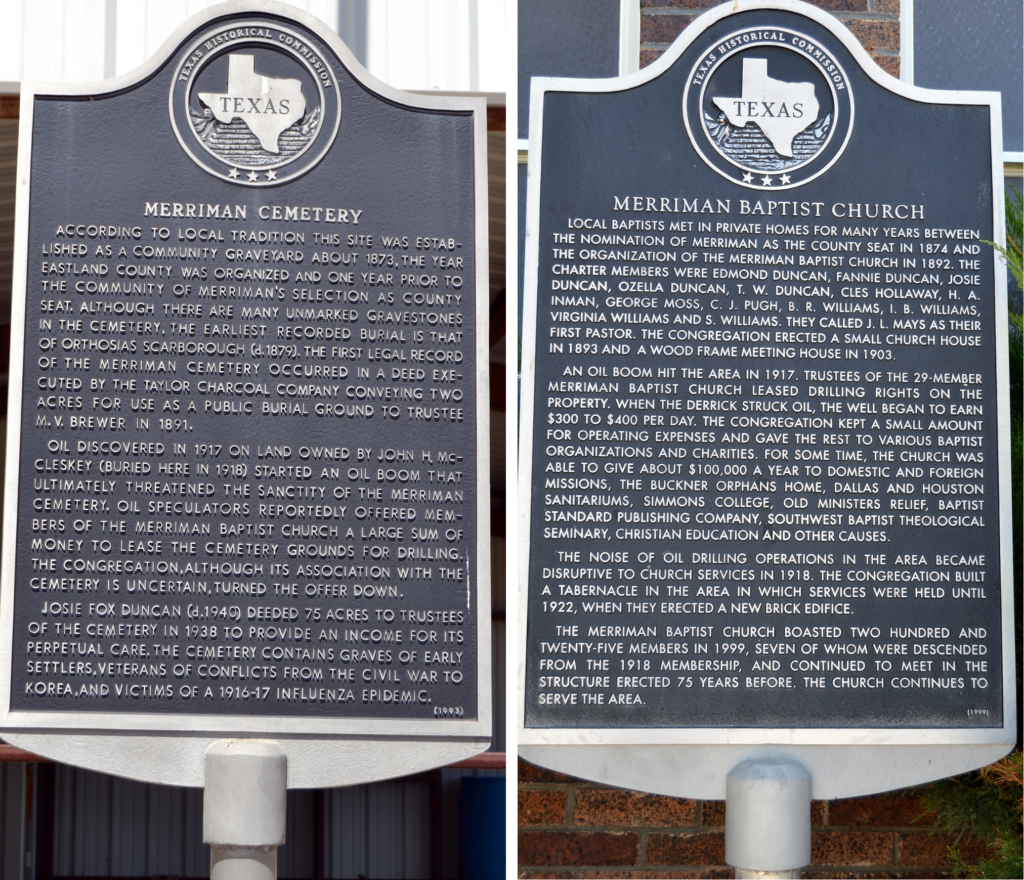
Near Ranger in Eastland County, Texas Historical Commission markers erected in 1993 (left) and 1999 explaining how members of the Merriman Baptist Church shared their wealth from petroleum royalties. Photos courtesy the Historical Marker Database.
When local newspapers reported the church had refused an offer of $1 million, the Associated Press picked it up and newspapers from New York to San Francisco ran the story. Literary Digest even featured, “the Texas Mammon of Righteousness” with a photograph of the “The Congregation That Refuses A Million.”
Deacon J.T. Falls was not amused. “A great many clippings have been sent to us from many secular papers to the effect that we as a church have refused a million dollars for the lease of the cemetery. We do not know how such a statement started,” the deacon opined.
“The cemetery does not belong to the church. It was here long before the church was. We could not lease it if we would and we would not if we could,” the cleric added.

“If any person’s or company’s heart has become so congealed as to want to drill for oil in this cemetery, they could not – for the dead could not sign a lease and no living person has any right to do so,” Falls proclaimed.
The church deacon concluded with an ominous admonition to potential drillers, “Those that have friends buried here have the right and the will to protect the graves and any person attempting to trespass will assume a great risk.”
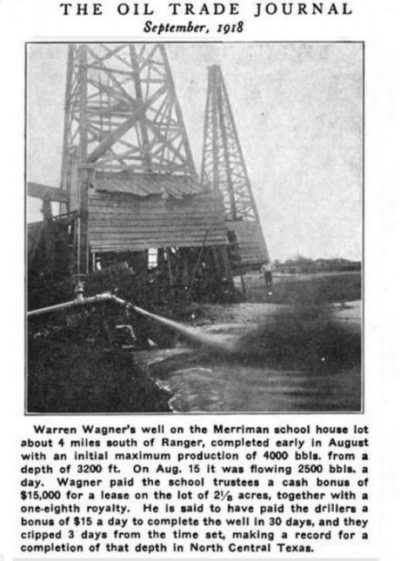
A 1918 article noted a “Merriman school house” oil well drilled to 3,200 feet in record time for North Central Texas.
Roaring Ranger’s oil production dropped precipitously because of dwindling reservoir pressures brought on by unconstrained drilling. Many exploration and production companies failed (including fraudulent ones like Hog Creek Carruth Oil Company).

In the decades since the McCleskey No. 1 well, advancements in horizontal drilling technology have presented more legal challenges to mineral rights of the interred, according to Zack Callarman of Texas Wesleyan School of Law.
Callarman wrote an award-winning analysis of laws concerning drilling to extract oil and natural gas underneath cemeteries. “Seven Thousand Feet Under: Does Drilling Disturb the Dead? Or Does Drilling Underneath the Dead Disturb the Living?” was published in the Real Estate Law Journal in 2014.
Despite yet another North Texas oilfield discovery at Desdemona, by 1920 the Eastland County drilling boom was over. The faithful still gather at Merriman Baptist Church every Sunday.
_______________________
Recommended Reading: Early Texas Oil: A Photographic History, 1866-1936
 (2000);Texas Oil and Gas, Postcard History
(2000);Texas Oil and Gas, Postcard History (2013);Wildcatters: Texas Independent Oilmen
(2013);Wildcatters: Texas Independent Oilmen (1984). Your Amazon purchase benefits the American Oil & Gas Historical Society. As an Amazon Associate, AOGHS earns a commission from qualifying purchases.
(1984). Your Amazon purchase benefits the American Oil & Gas Historical Society. As an Amazon Associate, AOGHS earns a commission from qualifying purchases.
_______________________
The American Oil & Gas Historical Society (AOGHS) preserves U.S. petroleum history. Please become an AOGHS annual supporter and help maintain this energy education website and expand historical research. For more information, contact bawells@aoghs.org. Copyright © 2025 Bruce A. Wells. All rights reserved.
Citation Information – Article Title: “Oil Riches of Merriman Baptist Church.” Authors: B.A. Wells and K.L. Wells. Website Name: American Oil & Gas Historical Society. URL: https://aoghs.org/oil-almanac/oil-riches-of-merriman-baptist-church. Last Updated: January 12, 2025. Original Published Date: January 18, 2019.




(2008). Your Amazon purchase benefits the American Oil & Gas Historical Society. As an Amazon Associate, AOGHS earns a commission from qualifying purchases.

















